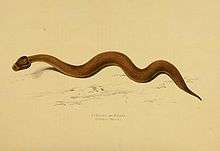Bitis inornata
| Bitis inornata | |
|---|---|
 | |
| Original illustration from A. Smith, 1838. | |
| Scientific classification | |
| Kingdom: | Animalia |
| Phylum: | Chordata |
| Subphylum: | Vertebrata |
| Class: | Reptilia |
| Order: | Squamata |
| Suborder: | Serpentes |
| Family: | Viperidae |
| Subfamily: | Viperinae |
| Genus: | Bitis |
| Species: | B. inornata |
| Binomial name | |
| Bitis inornata (A. Smith, 1838) | |
| Synonyms | |
Bitis inornata is a venomous viper species found only in Cape Province, South Africa.[1] No subspecies are currently recognized.[5]
Description
Adults average 25–40 cm (about 10-16 inches) in total length, with a maximum recorded total length of 45 cm (18 in).[2]
Geographic range
An isolated population exists on the Sneeuberg, eastern Cape Province, South Africa.[1]
The type locality is listed as "Sneeuwbergen, or Snow Mountains, ... immediately behind the village of Graaff Raynet" (Eastern Cape Province, South Africa).[1]
Spawls and Branch (1995) described it as known only from two isolated populations in southern Cape Province in South Africa: the first in the east, limited to the montane grassland of the Sneeuberge, from north of Graaff-Reinet to Cradock. A second population was discovered relatively recently on the upper slopes of the Cederberg in the west.[3]
Conservation status
This species is classified as vulnerable (VU) on the IUCN Red List for the following criteria: A2cd, B1+2ab.[6] This means a population reduction of at least 20% is projected or suspected to be met within the next ten years or three generations, whichever is the longer, due to a decline in the area of occupancy, extent of occurrence and/or quality of habitat, or due to actual or potential levels of exploitation. Also, the extent of occurrence is estimated to cover less than 100 km², or the area of occupancy is estimated to be less than 10 km², and the population is severely fragmented or known to exist at only a single location. Finally, a continuing decline has been observed, inferred or projected, in the area of occupancy (year assessed: 1996).[7]
See also
- List of viperine species and subspecies
- Viperinae by common name
- Viperinae by taxonomic synonyms
- Snakebite
References
- 1 2 3 4 McDiarmid RW, Campbell JA, Touré T. 1999. Snake Species of the World: A Taxonomic and Geographic Reference, Volume 1. Herpetologists' League. 511 pp. ISBN 1-893777-00-6 (series). ISBN 1-893777-01-4 (volume).
- 1 2 Mallow D, Ludwig D, Nilson G. 2003. True Vipers: Natural History and Toxinology of Old World Vipers. Malabar, Florida: Krieger Publishing Company. 359 pp. ISBN 0-89464-877-2.
- 1 2 Spawls S, Branch B. 1995. The Dangerous Snakes of Africa. Ralph Curtis Books. Dubai: Oriental Press. 192 pp. ISBN 0-88359-029-8.
- ↑ Brown JH. 1973. Toxicology and Pharmacology of Venoms from Poisonous Snakes. Springfield, Illinois: Charles C. Thomas. 184 pp. LCCCN 73-229. ISBN 0-398-02808-7.
- ↑ "Bitis inornata". Integrated Taxonomic Information System. Retrieved 26 July 2006.
- ↑ Bitis inornata at the IUCN Red List. Accessed 2 September 2007.
- ↑ 1994 Categories & Criteria (version 2.3) at the IUCN Red List. Accessed 2 September 2007.
Further reading
- Branch, Bill. 2004. Field Guide to Snakes and Other Reptiles of Southern Africa. Third Revised edition, Second impression. Sanibel Island, Florida: Ralph Curtis Books. 399 pp. ISBN 0-88359-042-5. (Bitis inornata, pp. 117–118 + Plate14.)
- Smith A. 1838. Illustrations of the Zoology of South Africa; Consisting Chiefly of Figures and Descriptions of the Objects of Natural History Collected during an Expedition into the Interior of South Africa, in the Years 1834, 1835, and 1836; Fitted out by "The Cape of Good Hope Association for Exploring Central Africa:" Together with a Summary of African Zoology, and an Inquiry into the Geographical Ranges of Species in that Quarter of the Globe. [Volume III. Reptilia.] London: Lords Commissioners of her Majesty's Treasury. (Smith, Elder and Co., printers.) 48 Plates + unnumbered pages of text. (Echidna inornata, Plate 4 + two unnumbered pages.)
External links
- Bitis inornata at the Reptarium.cz Reptile Database. Accessed 2 August 2007.
- Bitis inornata at Biodiversity.mongabay.com. Accessed 2 August 2007.
